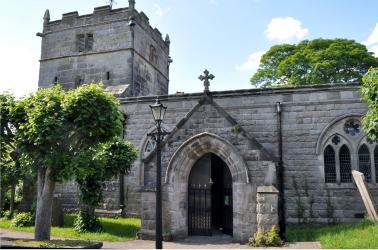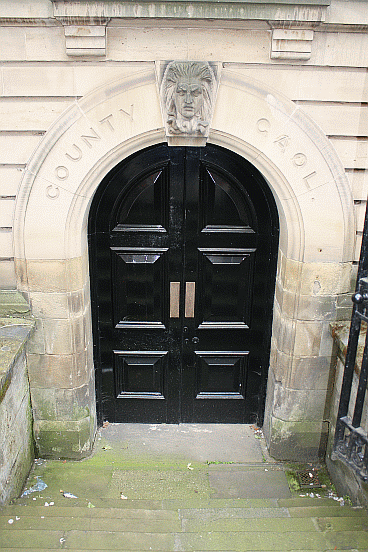
Thomas Allsopp was born in 1815 to Samuel Allsop (b.1792) and Mary Clark (1795-1832) and baptised 25 June 1815 at St Bartholomew’s Anglican Church, Hognaston, Derbyshire. His actual birth date remains unknown as it was not included in the baptism register.
On all documentation he is shown as Thomas Allsop, a native of Derbyshire except for the birth certificates of his children born to Jane Keating where he gives Nottingham as his place of birth, and John Thomas Allsop as his name. This combination of name and birth place may be a ruse to hide his background given that in the late 1830’s through to the mid 1840’s there was a push to abolish transportation, and was deemed by Fairfax (of newspaper fame) and others that the convicts were corrupting the moral character of Sydney society due to their immoral and lewd behaviour and participation in unnatural and depraved acts and didn’t want to be associated with it it.
Family stories in a number of lines have him linked to the brewery of Samuel Allsopp and Sons which would make his birthplace as Burton-on-Trent however no links have been found to prove the association and research to date indicates that this link is highly improbable. It is possible though that as his mother Mary’s birth in Tutbury, some 8km from Burton-on-Trent may be the source of the tale.

During his early years he lived in Derby along with his 5 siblings, George (b.1817), Mary (b.1819), Anne (1821-1824), Samuel (1822-1829) and John (b.1823). Some time before 1829 the family moved to Nottingham and settled in Pierrepont Road, West Bridgford. In 1830 Samuel and Mary had another child, a daughter Anne who was baptised at the St John the Evangelist Catholic church, quite strange…maybe converted to catholicism. It was here that Thomas’s mother, Mary, died in January1832 and in the October of that year Thomas was arrested in West Bridgford, along with a few mates for stealing a gander. He was tried and sentenced to 3 months imprisonment at the Southwell Correction Centre (located just north of Nottingham), and flogged.Just 4 days after his release from the Southwell Correction Centre, Thomas was arrested once more. He was tried at the Nottingham (town) Quarter Sessions on 10 April, 1833 charged with stealing a pair of shoes to the value of 5 shillings, the property of Robert Lownds and sentenced to 7 years imprisonment to be served by transportation to New South Wales. After leaving Nottingham Gaol in late April 1833 he was received at the Hulk ‘Justitia’, moored just off Woolwich and this became his home until being delivered to the ‘Lloyd’ on August 15th. Thomas left England behind on 19 August 1833, bound for Sydney.
Lower Right Arm: Mermaid, Sun, Half-Moon, Seven Stars, Woman, letters A A J A G A, M A, double Heart, 18, two Tobacco Pipes, Bottle and two Glasses.
Left Arm: Slaters Tools, two sears, double Heart pierced with two dots, letters I N B H, LOVE, S A, Anchor and several other letters or marks.
Back of left had: Mermaid
The initials tattooed on his arms reflect those of his father Samuel, and his living siblings at the time, Ann, John, George and Mary.
At 18 years of age he arrived in Sydney on the 18th December, 1833 aboard the barque Lloyds mastered by Edward Garrett. On arrival he was assigned to Dr John Henderson of Cooks River, Sydney, and later around 1836 went to work for Henderson’s father-in-law, ex-convict, Thomas Rose of Mt. Gilead, near Campbelltown, NSW. Thomas was one of about 14 convicts listed as being assigned to Thomas Rose when the 1837 Muster was conducted and remained in his employ when the windmill at Mt. Gilead was constructed, through to the death of Thomas Rose on 3 March, 1837.
It is suggested that he could write, however on the indent for the ‘Lloyds’ he is described as not able to read nor write, having brown hair and ruddy skin, and possessing a number of tattoos and identifying marks on his arms. These included:
Sometime around the death of Thomas Rose, Thomas was reassigned to Dr. John Henderson and appears not to have enjoyed his time there as it was reported in the Sydney Gazette in February 1838 that he had absconded from John Henderson, only to be apprehended in October that same year, and absconded on a second occassion and apprehended in February 1839. Thomas was granted a Certificate of Freedom in 24 April, 1840.
The following December at St Peters Cooks River he married Mary Ann Ridgely, born 12 Oct, 1825 in Parramatta NSW as Mary Ann Rudgely. They had two children, Ann (1842-1849) and William (1845-1927).
It is known that they were living on Liverpool Road, Ashfield in 1842 as it was here that Thomas was charged but not sentenced with theft from John Henderson, his former master.
A letter held by one of Thomas’ grand-daughters indicates that the couple went to Brisbane in 1846 with shipping records identifying a Mary Allsopp and 2 children traveling in steerage aboard the Steamer ‘William the IVth’ to Moreton Bay. According to the aforementioned letter, Thomas travelled overland, alone.
Whilst in Brisbane, Mary was charged and acquitted in July 1847 of passing a counterfeit coin and Thomas was hospitalised in Moreton Bay Hospital for 2 weeks in August 1847. No record of their return to Sydney has been found however a Mr Allsop travelled left Moreton Bay for Sydney 2 days after Thomas was discharged from hospital.
By late 1848 they were back in Sydney when in November 1848 Thomas was charged with ‘Breaching the Peace’, a charge related to Mary Ann running off to live with the actor Gustavus Arabin, taking their two children with her. This relationship does not appear to have lasted too long with Mary Ann turning to excessive drinking after their daughter Ann’s accidental death in 1849. Mary Ann died in 1858 from ‘disease brought on by intemperate habits’ in a lane off Castlereagh St, Sydney. She died alone but her death certificate gives her husband as Thomas Allsop. No children are shown which tends to indicate that William was with Thomas in the period preceding her death.
Sometime, probably around late 1852, Thomas formed a relationship with Jane Keating. Jane had earlier that year returned to Sydney from the Sofala goldfields. Jane Keating and her husband, Joseph Barker are recorded as being in the Sofala goldfields in September-December 1851 and it possible that Jane returned to Sydney for either the birth of her 2nd son William Joseph Barker, or the illness of her father (Philip Keating). Joseph remained around Sofala, dying in 1857 at Nuggety Gully, NSW.
The relationship between Thomas and Jane is evidenced by a letter from Jane petitioning the Colonial Secretary from Thomas’ release from gaol as she was destitute and had four children to support, believed to be William Henry Allsopp, Jane’s first child Emily Jane Keating, and Phillip Thomas and William Joseph Barker from her marriage to Joseph Barker.
Thomas had been arrested in January 1853 and sent before the judge at Sydney Quarter Sessions in March 1853 for assaulting Mary Fitzgibbon and sentenced to 3 months imprisonment in Darlinghurst Gaol. The assault took place in George Street, Sydney, not far from where the Keating family lived.
When tried in Nottingham, England his occupation was given as Slaters Boy and the fact that slaters tools were tattooed on his lower left arm tend reinforce this, however all documents pertaining to his life in Australia between the years 1857 and 1891 show him as either a labourer, goldminers or tinplate worker. It is suggested that he learned the latter skill from Jane Keating’s father, Phillip who was a wire worker.
During the period 1860 through 1864 he worked the goldfields of Sofala and Hill End.
On 22 Sept. 1891 Thomas died from bronchitis in Sydney Hospital, Sydney, NSW aged 76 years. Previously, he had been operated on for hernia, spending 2 months and 30 days in hospital, attended to by Dr. Davies.
Thomas was buried on 25 Sept. 1891 in the Church of England Section L, Rookwood Cemetery, Lidcombe, NSW, Australia. Although no details of any of his marriages or children appear on his death certificate there is considerable, although at times conflicting, information to confirm this fact.
Over the years there has been some conjecture that the Thomas Allsop who married Mary Ridgely was different to that who partnered Jane Keating, and that he that partnered Jane Keating changed his name to Joseph Barker to hide his convict background to marry Jane Keating.
DNA testing has put this conjecture to bed as I have links to 2 distinct lines of descendancy extending from Thomas Allsop, one through his son William Henry Allsopp, the other from his relationship with Jane Keating, and one from Joseph Barker though his son William Joseph Barker.
Documentary evidence lists Thomas’s children as being:
To Mary Ridgeley:
Ann Allsopp (1842-1849)
William Henry Allsopp (1845-1927)
To Jane Keating:
Ann Elizabeth Allsopp (1854-1922)
Samuel Henry Allsopp (1857-1931)
Jane Amelia Allsopp (1860-1942)
Cussiah Jane Allsopp aka Mary Rosina Allsopp (1862-1946)
Thomas Allsopp aka Elijah John Allsopp (1864-1944)
John Thomas Allsopp aka Frederick Thomas Allsopp (1865-1956)
Various documents list ‘several deceased’ but no other detail has been discovered to date.





Jane Adelaide Keating [1825 – 1895]
Image of Thomas Allsopp courtesy of Leah Clark.
